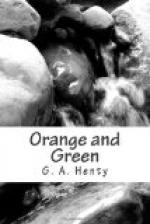The circulation of the report that General Sarsfield, with fifteen thousand men, was on the march to cut off the besiegers of Athlone, determined General Douglas to make a speedy retreat. In his fear of being cut off, he abandoned all his heavy baggage, and, quitting the high road, made his way by unfrequented routes, which added to the hardships of the march. In its retreat, the column was accompanied by the unhappy Protestant inhabitants, who feared to remain behind, lest the Irish should retaliate upon them the sufferings which had been inflicted upon their countrymen.
In the meantime, the main English army had done but little. In Dublin, a commission had been appointed to examine into and forfeit the lands of all Catholics, and adherents of King James, and having set this machine at work, the king proceeded with his army southward through Carlow, Kilkenny, and Waterford, all of which places surrendered, the garrisons being allowed to march out, with their arms and baggage, to join their main army on the Shannon.
At Waterford, the king received such serious news as to the state of things in England, that he determined to return home. On arriving at Dublin, he was overwhelmed with petitions from the inhabitants, as to the shameful conduct of the troops left in garrison there, especially those of Trelawney’s, Schomberg’s, and some other regiments of horse, who, the people complained, treated them, although Protestants, far worse than James’s Catholic soldiers had done. Inquiry showed these complaints to be well founded, and, finding it impossible to restore order and discipline among them, the king at once sent these regiments back to England.
Then, receiving better news from home, he again started to rejoin his army, and marched towards Limerick, being joined on his way by the division under Douglas, which had driven along with them all the cattle and horses of the country through which they had passed.
Limerick was, at that time, the second city in Ireland. The country, for a long distance along the mouth of the Shannon, was much wooded, but in the immediate vicinity of the town it was surrounded by thick inclosures, houses, orchards, gardens, and plantations. The cultivated land was everywhere divided into small fields, inclosed by hedges and intersected by lanes. To the east of the town the Shannon divides itself, forming an island on which part of the city is situated.
This was called the English town, and was connected by a bridge, called Thomond Bridge, with the Clare side of the river on the north; and on the south, by another bridge, with the Irish town on the county of Limerick side. The Thomond Bridge was defended by a strong fort and some field works on the Clare side, and on the city side by a drawbridge, flanked by towers and the city walls. The bridge was very long and narrow.
The position of the English town was, indeed, almost impregnable. It was built upon a rock of considerable extent, and the land outside the walls was low and marshy, and could at any time be flooded. The Shannon was broad and rapid. The Irish town on the Limerick shore was not strong, being defended only by ordinary walls. If this were captured, however, the English town could still hold out.




